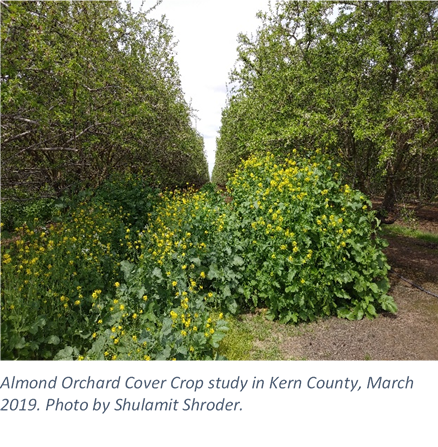Cover crops offer many potential benefits to growers. For example, they can improve water infiltration, reduce erosion, and provide habitat for pollinators and other beneficial insects.
But how does a grower figure out which cover crop species would work best for the specific conditions and concerns on their field?
Of course, it's a good idea to start off by talking to a local NRCS planner or Cooperative Extension farm advisor. There is also plenty of information available on the internet and in printed publications about different cover crop species – but it's not all in one place.
To help growers and planners sift through the available information and pick which cover crops will both provide the benefits needed and will survive in the specific conditions of their fields, I have been working on a cover crop selection tool since this past July.
I used the CalFlora eVegGuide and the UCANR cover crop database as jumping off points and the Southern Cover Crop Council's cover crop selection tool as inspiration.
To determine if a given cover crop will work for a specific field, the tool asks the user to provide the following information:
- The USDA hardiness zone of the field. The USDA has divided the country into hardiness zones based on average winter temperatures. The lower the number of the hardiness zone, the colder the place.
- How much water the cover crop will receive. This is an estimate, especially for growers who will plant winter cover crops and depend entirely on the rain. If you can provide some irrigation water to the cover crops during their growing season, then include that in your estimate.
- When the cover crop will bloom. Most growers will terminate their annual cover crops during peak bloom, to maximize growth and bee forage but minimize the likelihood of the cover crop turning into a weed. If you are planning on planting annual crops into the cover crop residue, leave a couple weeks between cover crop termination and cash crop planting to allow the residues to decompose.
- How much salinity does your soil have? This can be a major inhibitor of plant growth and most cover crops cannot tolerate high or even moderate salinity levels.
- What is your soil's pH? Like cash crops, cover crops have a specific range of pH values in which they can thrive.
- Does your soil flood often? Some species can tolerate poor drainage conditions better than others.
The other questions in the tool ask the user to rank the importance of various cover crop benefits to their operation. The benefits listed on this tool are:
- Compaction reduction (improves water infiltration)
- Residue persistence (acts as a mulch)
- Erosion control
- Weed control
- Nematode control
- Attract pollinators
- Attract other beneficial insects
- Fix nitrogen
- Scavenge nitrogen (reduces nitrate leaching)
- Scavenge P and K (reduces nutrient contamination of waterways)
- Forage quality
To test the selection tool and see if it will provide good options for your operation, go to http://cekern.ucanr.edu/CDFA_Grants/HSP_Grants/Cover_Crop_Selection_Tool/.
Questions or comments? Reach out to Shulamit Shroder at sashroder@ucanr.edu.
